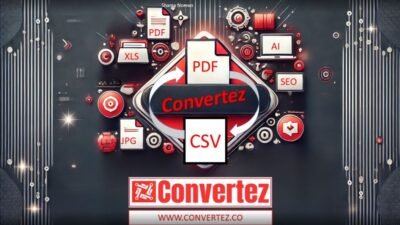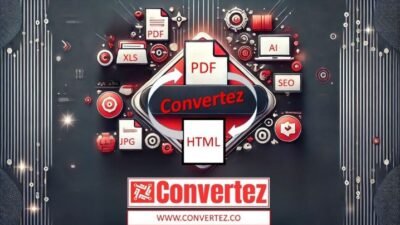In the ever-evolving digital age, file formats play a crucial role in how we create, share, and store content. One of the most common tasks many users face is converting documents and images into formats that are optimized for the web, email, or mobile use. One such conversion is PDF to WEBP, a process that transforms static PDF pages into high-performance WEBP images. Whether you’re a student, designer, developer, or content creator, understanding how and why to convert PDFs to WEBP can save time, improve performance, and streamline your workflow.
In this article, we’ll dive deep into the PDF to WEBP conversion process—what it is, why it’s useful, how it works, and the best tools to get the job done effortlessly.
What is PDF to WEBP Conversion?
PDF (Portable Document Format) is a universal file format created by Adobe to preserve the fonts, images, graphics, and layout of any source document, regardless of the device or software used to view it. It’s widely used for sharing documents, eBooks, forms, and reports.
WEBP, on the other hand, is a modern image format developed by Google that provides superior compression for images on the web. It supports both lossy and lossless compression, transparency (alpha channel), and animation—making it an excellent format for faster page load times and reduced bandwidth usage.
Converting PDF to WEBP means extracting pages or elements from a PDF file and saving them as WEBP image files. This is especially useful when you want to share or display PDF content as an image on websites, blogs, or apps.

Why Convert PDF to WEBP?
Here are some key reasons why users might want to convert PDF to WEBP:
1. Faster Web Performance
WEBP images are significantly smaller in size compared to JPEG or PNG without sacrificing quality. By converting PDF pages to WEBP, especially for image-rich documents, you reduce file size and improve page speed—an essential factor for SEO and user experience.
2. Web & App Compatibility
If you’re building a website or mobile app, embedding a PDF viewer can be complex or heavy. Instead, converting specific pages to WEBP allows easy integration as lightweight images.
3. Easy Sharing & Display
Images are easier to upload, share, or display on platforms like Instagram, blogs, or social media. A WEBP image can showcase a single page or a graphic from a PDF with minimal hassle.
4. Content Repurposing
You may want to repurpose PDF infographics, graphs, or illustrations into marketing content. Converting these pages to WEBP makes them ideal for blogs, websites, and digital marketing assets.
How to Convert PDF to WEBP?
Converting PDF to WEBP can be done in various ways—through online tools, desktop software, or code-based solutions. Here’s a breakdown of each method:
1. Using Online Tools (Best for Convenience)
If you need a quick and hassle-free conversion, online converters are your best bet. Websites like Convertez.co offer a PDF to WEBP converter that is fast, free, and user-friendly.
How It Works:
- Upload your PDF file.
- Choose the page(s) you want to convert.
- Click Convert and download your WEBP image(s).
Pros:
- No software installation
- Works on any device with a browser
- Simple and fast
Cons:
- File size or page limits may apply
- Internet connection required
2. Using Adobe Acrobat or Photoshop (Best for Professionals)
If you have Adobe software, you can open your PDF in Photoshop or Acrobat and export pages as images, including WEBP (if supported or via a plugin).
Steps in Photoshop:
- Open the PDF file.
- Choose the page and resolution.
- Export or “Save As” → Choose WEBP format.
Pros:
- High control over quality and resolution
- Suitable for professional design use
Cons:
- Requires paid software
- Not beginner-friendly
3. Using Command-Line Tools (Best for Developers)
For automation and scripting, tools like ImageMagick or pdf2image (Python library) can convert PDFs to WEBP in batch or via scripts.
Sample with ImageMagick:
bashCopyEditconvert -density 300 input.pdf -quality 90 output.webp
Pros:
- Ideal for batch processing
- Fully customizable
- Great for backend or SaaS applications
Cons:
- Requires technical knowledge
- Needs installation and configuration
Best Practices for PDF to WEBP Conversion
To get the most out of your conversion, follow these best practices:
✅ Optimize PDF Before Conversion
Remove unnecessary elements like unused fonts, empty pages, or embedded scripts. A cleaner PDF converts better.
✅ Choose the Right Resolution
Higher DPI (e.g., 300) results in sharper images but larger file sizes. Adjust according to your needs.
✅ Batch Conversion
Use tools that support multiple pages or files in one go if you’re dealing with large documents.
✅ Test WEBP Compatibility
While most modern browsers support WEBP, ensure your website has fallback options for older browsers if needed.
When Not to Use WEBP?
While WEBP offers great benefits, it might not be suitable in these cases:
- You need a vector-based format (like SVG) for resizing without quality loss.
- You’re printing content, where PDF or TIFF may be better.
- Your audience uses browsers or apps that don’t support WEBP.
Conclusion
The ability to convert PDF to WEBP opens up new possibilities for presenting static documents in a visually engaging and efficient format. Whether you’re enhancing your website’s speed, repurposing content for digital marketing, or simply looking for an easy way to share parts of a PDF, WEBP is a powerful format to consider.
Thanks to tools like Convertez.co, this conversion can be done in seconds—no tech skills needed.


